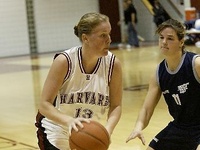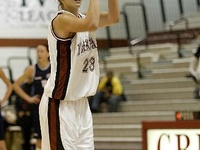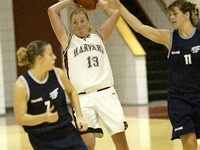The situation with Mannering is quite similar. She is also returning from an injury and will look to improve beyond her restricted abilities last year by penetrating into the paint with her speed.
“Kate, who missed most last season with a broken thumb, is a poised slasher,” Tubridy said. “Both of them [Mannering and McCaffery] are strong players who are going to play a vital role in our games this year.”
McCaffery is actually another sophomore recovering from mononucleosis. At 6’1, she still has the skills to be a legitimate perimeter threat.
“McCaffery just was outstanding in Europe,” Delaney-Smith said. “She’s a front court player who can shoot the three like no one in the world, except for Kate Ides [’03]. As I said, I think Maureen was a defensive force in Europe.”
Complementing these three sophomores coming off of the bench will be Lackner, one of two freshman recruits.
Already, she has begun to impress her coaches and upperclassmen teammates, drawing comparisons to established impact players.
“[Lackner] has remarkable athleticism for a forward,” Delaney-Smith said. “She admires the way Hana plays and is copying some of the things Hana does as far as that, which I think is fabulous for a freshman to do to a senior, especially Hana. She has the most gorgeous hook shot, almost like a Katharine Hanks.”
Hanks was Dartmouth’s main threat last year, scoring 18.9 per game and pulling in 8.8 rebounds.
But while the bar is set high for Lackner—just as it was with Peljto, Tubridy and Cserny—she will come off the bench to add depth to the already strong trio of starters.
“[Lackner] is really strong in the paint, she shoots well from outside, she is quick, she is a good defensive player and she is motivated,” said Cserny. “What else do you need? I’m sure she will make our front court even better than it has been.”
And considering that the Crimson went undefeated in Ivy League play last year, that is a scary thought for Harvard’s opponents.











